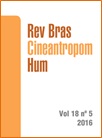Indicadores antropométricos como instrumento de triagem para quedas em idosos
DOI:
https://doi.org/10.1590/1980-0037.2016v18n5p530Resumo
Indicadores antropométricos instrumentalizam profissionais para predizer risco de quedas em idosos, entretanto, há lacunas de evidências na literatura sobre valores de referência. O objetivo foi analisar os indicadores antropométricos como testes de rastreio para quedas em idosos. Estudo com delineamento transversal de base populacional, amostragem sistemática, realizado por meio de inquérito domiciliar e avaliação da composição corporal. As medidas antropométricas foram aferidas por meio de uma balança eletrônica e estadiomêtro portátil. Utilizou aparelho de Bioimpendância para análise das medidas do índice de massa corpórea, gordura corporal e massa corporal magra. Adotou-se queda nos 12 meses anteriores à entrevista como variável dependente. Foi realizada análise discriminatória para quedas por meio da curva ROC, sensibilidade, especificidade, valores preditivos positivos e negativos. Participaram 275 idosos, cuja prevalência de quedas foi de 23,6%. O índice de massa corporal médio foi igual a 27,8kg/cm2 e 52,1% estiveram em sobrepeso. Entre os homens idosos, a estatura (ROC=0,68; IC95%=0,54-0,78) e massa corporal magra (ROC=0,63; IC95%=0,58-0,76) foram associadas à ocorrência de queda. Ao considerar os pontos de corte 52,2kg e 166cm, obteve-se sensibilidade de 75% e altos valores preditivos negativos (88,1% e 89,1% respectivamente). Para as mulheres, a massa corporal magra (ROC=0,61; IC95%=0,30-0,49) e a massa corporal (ROC=0,60; IC95%=0,53-0,72) foram relevantes a partir do ponto de corte de 28,9% e 57,2kg/m2. A massa corporal magra foi mais sensível (63,2%) e a massa corporal pouco mais específica (64,3%), ambos com altos valores preditivos negativos (82,0% e 83,0%). Os indicadores adotados foram capazes de discriminar idosos que sofreram quedas.
Downloads
Publicado
Edição
Seção
Licença

Direitos Autorais para artigos publicados nesta revista são do autor, com direitos de primeira publicação para a revista. Em virtude da aparecerem nesta revista de acesso público, os artigos são de uso gratuito, com atribuições próprias, em aplicações educacionais e não-comerciais, desde que seja dada a atribuição. Esta obra foi licenciada com uma Licença Creative Commons Atribuição 4.0 Internacional - CC BY


